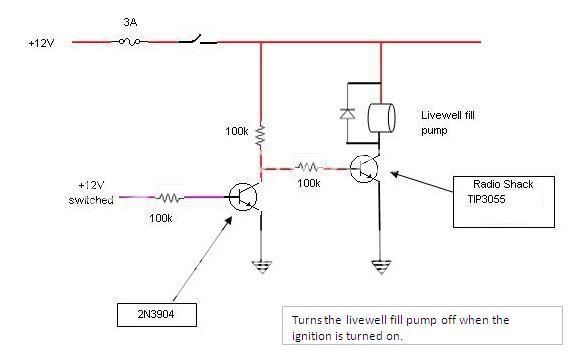pn junctionitis
Newbie level 3
- Joined
- Mar 23, 2008
- Messages
- 4
- Helped
- 0
- Reputation
- 0
- Reaction score
- 0
- Trophy points
- 1,281
- Location
- Texas. USA
- Activity points
- 1,325
Rank amateur here. In fact this is my first attempt at constructing a useful electronic device, but there's something here that I just don't know about, and I can't figure it out.
The application: my boat has a livewell fill pump which should be off while the boat is under way, but it's easy to forget to switch it off. So a circuit that simply disables the pump while the ignition is on, using a radio shack TIP3055 power transistor. It's a 12-volt system, meaning it needs to work at 12.6 to around 15 volts. The pump is on a 3 amp fuse, I expect it draws 1 to 1.5 amps during normal operation.
In my bench tests the voltage across the load with "ignition" switched off is a little over 4, enough to turn an LED on and off, but not enough to spin a small electic motor (225ma at 11.76 volts).
What am I missing here?

3055 datasheet
https://www.bourns.com/pdfs/tip3055.pdf
Thanks!!
The application: my boat has a livewell fill pump which should be off while the boat is under way, but it's easy to forget to switch it off. So a circuit that simply disables the pump while the ignition is on, using a radio shack TIP3055 power transistor. It's a 12-volt system, meaning it needs to work at 12.6 to around 15 volts. The pump is on a 3 amp fuse, I expect it draws 1 to 1.5 amps during normal operation.
In my bench tests the voltage across the load with "ignition" switched off is a little over 4, enough to turn an LED on and off, but not enough to spin a small electic motor (225ma at 11.76 volts).
What am I missing here?

3055 datasheet
https://www.bourns.com/pdfs/tip3055.pdf
Thanks!!
